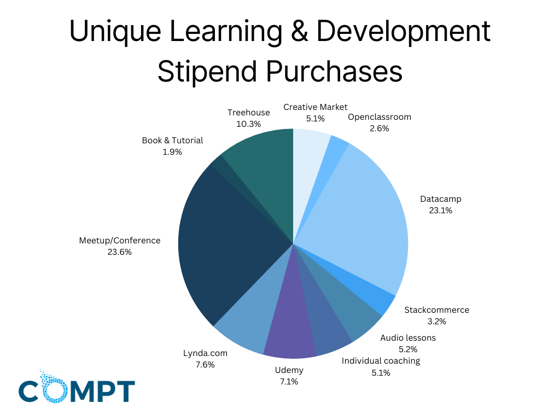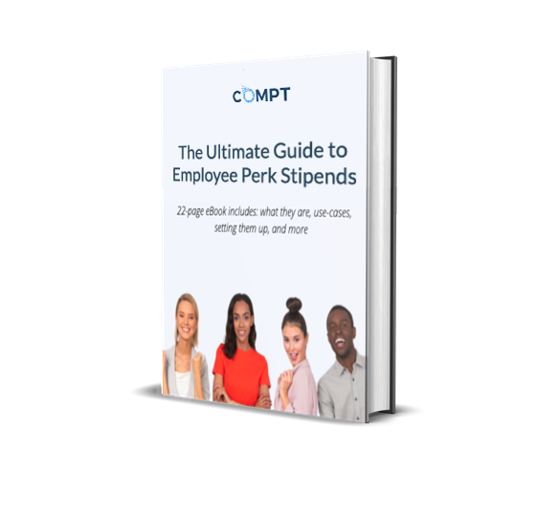An employee stipend is a sum of money given to employees dedicated to cover expenses in categories like health & wellness, professional development, and more.
By Amy Spurling
As the old way of selecting individual vendors for perks becomes less valuable for employees and more administrative-heavy for HR, companies are leaning on employee stipends to solve both problems while further delighting their people.
That's why we developed this guide with everything you need to know about this fringe benefit: stipends.
First, a definition:
An employee stipend is a sum of money given to employees dedicated to cover expenses for various purposes.
Perk stipends help employers put the money and choice in the hands of employees so they can get the lifestyle benefits they want and need most.
They're also referred to as:
They are becoming increasingly popular in today’s work climate because they dramatically improve the process of offering perks for HR team members, streamline accounting and taxability for finance teams, and more importantly, improve the experience for employees.
In the example to the left, Sam's company has allocated $100 per month to her and other employees to spend on the following perk categories: continuous learning, health & wellness, and food.
This month, Sam purchased books, a gym membership, paid for lunch with her team, and still has $20 remaining.
How would you spend $100 this month?
We're living in the age of personalization. Everything in our daily lives from our Netflix subscriptions to Spotify playlists to iPhones is customized to us and our unique preferences.
Employee stipends, or lifestyle spending accounts, are the best method for companies looking to introduce more personalization to employee benefits without adding complexity.
Here's a short list of companies using employee stipends:
After analyzing their employees' stipend usage, they noticed their people were using many different platforms to learn.
15 unique platforms to be exact.
How could HR create a program that supports this diversity of needs?
This is the power of an employee stipend. 👉
Below are some of the more popular stipends we see at Compt:
Don’t have time to go through this comprehensive guide right now? That's ok!
You can read this content later but still take advantage of additional information about perk stipends! We like to make it simple.
This new approach to employee perks has seen a lot of media attention (and attention from HR influencers) because it solves so many common problems of traditional perk programs and it also addresses the trends that are shaping the future of work.
So what exactly are the benefits for companies and employees?
Employee stipends give your team access to the lifestyle benefits they actually want and need.
Pet insurance, in-office yoga, and financial planning services are excellent perks, but often only a small percentage of a team can or will use them. Low utilization burns cash!
Stipends create a flexible, personalized perk experience, and since employees get more control over how they use it, they're more likely to engage. That's a budget win!
HR is no longer forced into trying to pick the "perfect perk" or perfect vendors with its limited budget and time. Imagine having to sort through 27,000+ vendors to make sure every employee gets what they want...
[Want to see how much your perk vendors are costing you? Check out our Perk Vendor Calculator.]
Save time on the implementation side as well as ongoing administrative. Stipends mean less time-consuming and labor-intensive tasks and more automation.
Finally, your CFO will be able to sleep comfortably at night knowing your perks are appropriately taxed (if you use Compt, that is). And, they have you to thank for that.
With Lifestyle Spending Accounts, companies no longer experience expired food, wasted event tickets, or under-attended in-office fitness sessions.
Happy hour might sound like a great idea, but what percentage of your team actually likes drinks or has the time or desire to attend the event? Avoid usage for the sake of usage. Start saving money and resources by offering more inclusive perks.
Gain a competitive edge by approaching perks strategically and aligning them with what matters to the business.
Looking for a detailed description of how real Compt customers use Lifestyle Spending Accounts? Click here to learn more.
[Actively comparing various perk vendors? Check out our guide, Comparing Perk Software: Everything You Need to Know]
If you already offer your team a stipend, awesome! You're ahead of the curve and you're likely experiencing a tremendous amount of the benefits mentioned above. High-five!
However, there's likely a problem you're encountering right now and that is: the admin work.
Unless you're using software to streamline the management of your employee stipend, you're likely spending countless hours managing the following:
If these found familiar, you're not alone. Some companies we've spoken to Compt told us they were spending 20+ hours a week managing these details for a company with less than 200 people. That's 50% of one person's week, or worse and likely more accurate, a percentage of multiple peoples' time invested just on managing the process.
If you feel like the cost of managing the administrative tasks and work is too much to handle, consider implementing a perk stipend management software.
The number of software options to manage perks has grown tremendously in the last few years (trust us, we know). We want to help you select the best perks program for you, so we've built this handy worksheet with all the Compt details you need when evaluating vendors.
Whether you're creating a perks program or a lifestyle benefits program from scratch or are looking to make updates to an existing one, adding personalization to your perks program can achieve many of the same goals that traditional perk programs do, while giving you (and the rest of your organization) more benefits.
Companies usually begin looking to employee stipends when they want to:
Setting up a traditional perk program from scratch takes seven steps and constant tweaking to get it right. Lifestyle Spending Accounts allow for an easier process and happier employees.
Follow these 5 steps to set up an employee stipend program:
Timeframes could be monthly, quarterly, semi-annually, annually, or on a one-time basis.
These could align with your company's mission, values, and goals, or be 100% open to give employees complete freedom over their perks. Popular categories include health & wellness, continuous learning, family, food, and travel.
Below are some of Compt’s most popularly used employee stipends (categories in which employees can spend their perk money):
If you use perk management software like Compt, this could take 15 minutes.
Or if you're doing it manually - develop a spreadsheet/form where you can manually track the individual perk expenses, total amounts remaining within each time frame, collect receipts, account for taxes, data for finance, and the status of each perk expense.
Draft up an email, or better yet, a page on your internal wiki to communicate the new perks plan.
Remember to explain the why, what, when, and how details.
To supercharge your communication plan, create a forum for people to provide feedback. A simple Google form can help or hold a series of office hours.
[Starting with stipends? Check out this detailed guide on how to set up your perk stipend.]
Curious about what people actually spend their stipends on? We've pulled together some actual purchases from Compt users.
We're here to talk through your company's current goals and challenges with perks, and see if employee stipends can help you achieve greater success.


